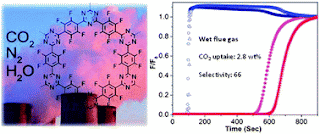 Yavuz and team reported that disulfide linked network polymers from aliphatic building blocks show selective uptake by swelling when treated with ethers and chloro-alkanes. Although the polymers are non-porous, the gate opening behavior by certain functional groups could provide effective separations. Since water and alcohols are almost rejected, it could be useful in water treatment or product separation in chemical industry.
Yavuz and team reported that disulfide linked network polymers from aliphatic building blocks show selective uptake by swelling when treated with ethers and chloro-alkanes. Although the polymers are non-porous, the gate opening behavior by certain functional groups could provide effective separations. Since water and alcohols are almost rejected, it could be useful in water treatment or product separation in chemical industry.Reference:
Exceptional organic solvent uptake by disulfide polymeric networks
H. A. Patel, M. S. Yavuz, C. T. Yavuz*
RSC Adv., 2014, 4, 24320-24323 DOI: 10.1039/C4RA03355H




